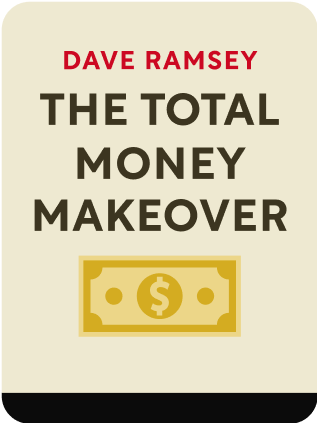

This article is an excerpt from the Shortform book guide to "The Total Money Makeover" by Dave Ramsey. Shortform has the world's best summaries and analyses of books you should be reading.
Like this article? Sign up for a free trial here .
What are the seven Total Money Makeover steps? How do Dave Ramsey’s 7 steps help you get to financial health?
The Total Money Makeover steps are the seven actions you need to take to live a better life. You get to a debt-free state and be set up to enjoy your money later with Dave Ramsey’s 7 steps.
Read on for seven the Total Money Makeover steps.
The Seven Total Money Makeover Steps
Now you’re ready to begin the process of putting your financial problems behind you by following these steps in sequence:
Step #1: Save $1,000 Cash
Everyone needs a rainy day fund because it’s guaranteed to rain—there’s always a financial emergency at some point.
Saving $1,000—fast—is the first of the Total Money Makeover steps because, without a financial cushion for emergencies, an unexpected expense will prompt you to dig yourself deeper into debt by borrowing more. Granted, $1,000 won’t get you through a life-altering crisis, but it’s enough to keep smaller crises from triggering debt. You’ll build on this amount in step #3 when your finances are in better shape.
Do whatever you can to round up $1,000: cut your spending, work extra hours, or sell something (by having a yard sale, for example). Most people can find the money in less than a month, but if you can’t, sell more or take on an extra job.
When you get $1,000, stash it where it’s accessible in an emergency but not so easy to grab that you’ll be tempted to spend it for non-emergencies (for instance, by keeping it in your sock drawer).
Step #2: The Debt Snowball
You need to get rid of debt to get control of your income and put it to work for you. The debt snowball method is the way to pay off debt. There are two steps:
1) List your debts in order, from the one with the smallest balance to largest. Exclude only your mortgage, which will be addressed in another step.
2) Each month, apply every extra dollar you have after basic expenses toward paying the smallest debt until it’s paid off. Make the minimum payments to stay current on the other debts on the list.
After the smallest debt is paid, apply the payment you had been making on it, plus any additional money you have, toward paying off the next smallest debt. When the second debt is paid off, apply the payment amounts from the first two debts, plus any other money you can find, to the third debt on your list, and so on.
Each time you pay off a debt, you increase the amount you can pay on the next one—your payments continue to snowball until your debts are paid off.
Step #3: Boost Your Emergency Fund
The next of the Total Money Makeover steps is boosting your emergency fund to give yourself a cushion against life-disrupting problems like a job loss or medical bills.
You need an emergency fund large enough to cover three to six months of expenses, enabling you to manage for up to half a year without an income. In one survey, 49% said they couldn’t cover even a month’s expenses if they lost their income. To make sure you’re not in this situation, the amount in your emergency fund should be between $5,000 and $25,000.
As noted in step #1 (create a $1,000 emergency fund), your emergency fund must be in the form of cash and easily accessible. A great option is a money market account with no penalties, and on which you can write checks.
Step #4: Save for Retirement
The next of Dave Ramsey’s 7 steps is building your wealth by investing for retirement—it’s the key to being financially fit for life.
Invest 15% of your gross annual income for retirement, and make compounding interest work for you. When calculating your 15%, base it on your gross annual income before taxes. Exclude any company 401(k) match, as well as potential Social Security benefits. You can’t count on the government coming to your aid in future years—it’s your job to provide now for your future needs.
The best way to build your wealth over time is to invest in growth-stock mutual funds. Mutual funds go up and down in value in the short term, but over the long term (more than five years), they provide an average 12% annual return on investment.
Choose mutual funds with a record of growth for more than five years, preferably 10. Spread your investment dollars over four types of funds:
- Growth and Income (25%), also called large cap or blue chip funds
- Growth funds (25%), also called mid cap or equity funds
- International funds (25%)
- Aggressive growth (25%), also called small cap or emerging market funds
When deciding where to invest first:
- Start with your company 401(k) plan if the company provides a match.
- After that, fund two Roth IRAs. You and your spouse can each invest up to $5,000 a year in a Roth IRA and it grows tax-free. Investing $3,000 a year from age 35 to 65 will give you $873,000 tax-free at age 65—for a $90,000 investment.
Step #5: Save for College
While most people think college is important, most don’t save for their children’s college education, and they end up taking out huge loans (which people think is “normal”).
Save for college and pay cash. The most effective vehicles for saving for college are an ESA (Educational Savings Account), which is like an IRA for education, and a state 529 plan.
College tuition increases faster than inflation, at about 8% versus 4%, so when you save for college, you need to factor in tuition inflation. There are tuition prepayment plans, but they just break even with inflation.
You can do much better with an ESA funded in a growth-stock mutual fund—like an IRA, it will grow tax-free. Here’s how it compares to a prepaid tuition plan:
- If you invest $2,000 a year from your child’s birth through age 18 in a prepaid plan, you’d have $72,000 for tuition.
- An ESA in mutual funds returning 12% would generate $126,000 tax-free. It would take only $166.67 a month to save $2,000 a year, and in 18 years, you’d have enough to send your child to an expensive college. But you could still probably afford a typical college if you started investing when the child turned 8.
If you need more, also consider a state 529 plan, which similarly allows you to invest money tax-free for your child’s education. There are several types of 529 plans—stay away from the “life phase” (poor returns) and the “fixed portfolio” plans (too restrictive). The best option is a “flexible” plan that allows you to move your investment within a family of funds to get better performance.
Step #6: Pay Off Your Mortgage
At this point in the Total Money Makeover steps, you’re nearly debt-free, you have an emergency fund covering three to six months of expenses, you’re investing 15% of your income, and you’re saving for your kids’ college education. Your next step is to pay off your mortgage and become 100% debt-free.
Most people believe that paying off a mortgage, especially early, is next to impossible. But numerous Total Money Makeover adherents do it. For three to five years, they live differently from everyone else—sacrificing by spending less and working extra hours to pay off their mortgage. Then they continue to live differently from everyone else by being debt-free.
The biggest myth about home-buying is that you need a mortgage in the first place—that it’s the only way to pay for a home. There’s another way: paying 100% down. Paying cash for a home is possible if you save enough, long enough.
That said, if you choose to take out a mortgage, follow these two rules:
- Stick with a 15-year, fixed-term mortgage (not 30 years, which keeps you in debt too long and costs you too much in interest).
- Don’t commit to payments that exceed 25% of your monthly take-home pay.
This is the only kind of debt acceptable in the Total Money Makeover, but you should pay it off early at this point in the program.
Step #7: Enjoy Your Money
Completing six Total Money Makeover steps puts you in rare company—among the 2% of Americans who are debt-free. Because you’re debt-free, live on a budget, and have money for emergencies, you’re in control of your income and are building wealth. The only remaining question is what to do with your discretionary income.
There are three purposes for money:
- Having fun
- Growing your nest egg
- Giving
You should do all three of these things. Achieving financial fitness is like achieving physical fitness. You didn’t put in the work just to look good. Now you get to use your financial muscle:
- Have fun: If you want something and can afford it, by all means, indulge yourself—you’ve earned it. Up to this point in the Total Money Makeover, you’ve sacrificed by paying off debt and saving for the future—and like a kid who’s behaved so he can have ice cream later, you deserve a reward.
- Grow your nest egg: At this step, you need to keep growing your wealth. While your nest egg may be substantial, if it’s under $10 million, continue to keep your investing simple. You’ll eventually reach a turning point where your money is, in effect, working more than you are—that is, when you can live on your investment income. To determine whether you’re ready, multiply your total investments by .08, and if you can live on that amount annually, don’t be afraid to start drawing on your nest egg at up to 8% a year.
- Give: This may be the most rewarding thing you can do with money. You don’t have to be rich to help people, but you can often do more with money. Wealth gives good intentions greater impact; it also gives you the opportunity to help on a large scale.

———End of Preview———
Like what you just read? Read the rest of the world's best book summary and analysis of Dave Ramsey's "The Total Money Makeover" at Shortform .
Here's what you'll find in our full The Total Money Makeover summary :
- The 7 steps to achieving financial stability (you'll love #7)
- A fool-proof plan for becoming debt-free
- How myths about debt and money are crippling your financial health






